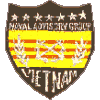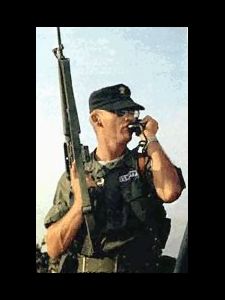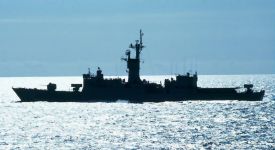Harold Dale MeyerkordLieutenantRVN RAG-23 (DUC TONG), NAVAL ADVISORY GROUP, MACV United States Navy 09 October 1937 - 16 March 1965 St Louis, Missouri Panel 01E Line 096 |


| |
 
|

|
The database page for Harold Dale Meyerkord
|
I never knew Lieutenant Meyerkord, I didn't join the Navy until April 2nd, 1966, but I read that he was the first Naval Officer to be killed in Viet Nam. He patrolled the rivers of Viet Nam, he was the first of River Rats in the brown water Navy. From a fellow sailor - I honor you, LT, rest in peace.
Carlos X. Esqueda |
|
I knew Lieutenant Meyerkord, and served with him in the Navy Section MAAG (later to become the Navy Section, MACV and still later the Commander, Naval Forces Vietnam) under the command of Captain Bill Hardcastle. Lieutenant Meyerkord served with River Assault Groups (RAGs) in the Mekong Delta and operated out of My Tho, Can Tho and Na Be among other places along with his American crew and Vietnamese counterparts. At that time the RAGs patrolled the rivers, canals and estuaries aboard Stacans (twin-hulled shallow draft boats inherited from the French) which had no armor at all. Above the deck connecting the two hulls was a canvas canopy to provide some protection from the sun. In the delta it is not unusual to have 19-20 foot (and even higher) tides and from what I learned from several chief petty officers who worked directly with Dale and from the Lieutenant, himself, when the tide went out their craft was sometimes mired on the bottom of the canal. In several of the after-action reports which I helped the Lieutenant prepare, he referred to that phenomenon and how that left him and his men exposed to incoming fire from Viet Cong perched atop the levees bordering the canals. As described by him, the only successful way to return fire was to use a grenade launcher and to try and aim it in such a way as to have the grenades come down on top of the VC. Lieutenant Meyerkord's immediate U. S. Navy superior was a commander who was very much piqued at "Hornblower" (Lieutenant Meyerkord's "handle") in part because Captain Hardcastle insisted Dale give his after-action reports directly to him instead of through the chain of command. I well remember the occasion when two chief petty officers came to me (at that time I was a PO1) and asked if there was anything I could do to help them in getting Dale recommended for a Silver Star. He had earlier been awarded 3 Bronze Stars for his actions under fire. They told me that the commander (Lieutenant Meyerkord's superior) would not let them submit a recommendation for that award let alone any other. That commander was in what was basically a desk job and, from knowing him to a small degree, I believe he was somewhat jealous of the attention given to Dale. I helped the chiefs prepare the proper paperwork, kept a copy of it, and told them to give it to the commander. I also provided them with a copy of the regulations which required that the commander had to forward the recommendation up the chain of command even if he recommended disapproval of it. I was prepared to go directly to Captain Hardcastle myself if necessary. Unfortunately, soon thereafter Dale was killed and the recommendation for the Silver Star never got submitted. A man full grown at that time (I was 30) I was stunned and wept when I learned of his death. As we all know, the Navy Cross was awarded to him posthumously. Everybody who personally knew Lieutenant Meyerkord, and especially those who served directly with him, believed he should have been recommended for the Medal of Honor but the thinking of the brass was that the MoH would not be approved for service in Vietnam. That he was not awarded the Medal of Honor was an insult to the concept of valor. Of all the other officers with whom I served, all of whom were effective leaders and outstanding men save but a few who would properly be called martinets, Lieutenant Harold Dale, Meyerkord, Jr., was the most exceptional junior officer of them all. He took care of his men even above his own safety and went far more than the extra mile to effectively carry out his missions. Others would tell you of the numerous low level flights he begged for to personally reconnoiter before going into battle for which he was awarded the Air Medal with a number of stars for multiple awards - a rarity for Navy surface warfare officers. I can only tell you of the regard, honor and respect I had for him and the deep regret I had when the Navy and our America lost this true hero.
Albert M. Forget |
Notes from The Virtual Wall
Lieutenant Meyerkord commonly is cited as the "first Naval Officer to be killed in Viet Nam" - but he wasn't. Before his death on 16 March 1965, 21 other Naval officers had died or were missing in action as a result of service in Vietnam. The first Naval officer actually killed in action within South Vietnam was Lieutenant Bruce C. Farrell, a flight surgeon assigned to HMM-361. LT Farrell, along with twelve others, was killed in action when two Marine UH-34 helicopters went down during a search-and-rescue effort for an Air Force pilot. Whether he was first, second, or twenty-third makes no difference; Lieutenant Meyerkord served with distinction. He received his commission through Officer Candidate School, served in USS LOS ANGELES (CA-135) and USS DUNCAN (DDR-874), and arrived in Vietnam for duty with the Naval Advisory Group on 13 July 1964. After arrival he made a habit of flying low-level recon with Army helo units in order to improve his knowledge of the canals and rivers in his operating area. He earned the respect of his subordinates, Vietnamese colleagues, and superiors. And finally, he earned the Navy Cross for acts of valor in combat.

Seven years after his death, USS MEYERKORD (DE-1058) was operating off the coasts of North and South Vietnam. 
|
|
Top of Page
www.VirtualWall.org Back to |
With all respect
Jim Schueckler, former CW2, US Army
Ken Davis, Commander, United States Navy (Ret)
Memorial first published on 07 Sep 2007
Last updated 11/13/2010